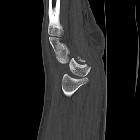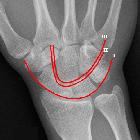carpal dislocation
 ähnliche Suchen
ähnliche Suchen siehe auch
siehe auchMayfield classification of carpal instability, also known as perilunate instability classification (carpal dislocations), describes carpal ligament injuries.
Instability has been divided into four stages :
- stage I: scapholunate dissociation (rotatory subluxation of the scaphoid)
- disruption of the scapholunate ligament with resultant Terry Thomas sign
- exacerbated in clenched fist views
- stage II: perilunate dislocation
- the lunate remains normally aligned with the distal radius, and the remaining carpal bones are dislocated (almost always dorsally)
- the capitolunate joint is disrupted, and the lunate projects through the space of Poirier
- 60% are associated with scaphoid fractures
- stage III: midcarpal dislocation
- lunotriquetral interosseous ligament disruption or triquetral fracture
- neither the capitate or the lunate is aligned with the distal radius
- stage IV: lunate dislocation
- dorsal radiolunate ligament injury
- dislocation of the lunate in a palmar direction
- tipped teacup appearance
History and etymology
This classification was described by Mayfield et al. in 1980 .
Siehe auch:
- Gilula-Linien
- Terry-Thomas sign
- perilunäre Luxation
- Scapholunäre Dissoziation
- Lunatumluxation
- Luxation Mittelhandknochen
und weiter:
 Assoziationen und Differentialdiagnosen zu karpale Luxationen:
Assoziationen und Differentialdiagnosen zu karpale Luxationen:









